Belgian Malinois were originally bred to be herding dogs, but nowadays, they work as guard dogs, military dogs, and police dogs, as well as dogs for personal protection.
For them to perform their purpose properly, they need to fit the breed standard. This is easier if you know the Belgian Malinois growth chart.
If you’re interested in becoming a dog owner, you need to understand all there is about this breed. For example, you should know that these dogs require lots of physical activity and a strict owner who will conduct proper dog training from day one. These are strong, intelligent dogs that make great family companions.
Many people confuse them for German Shepherds, but there are many things that set them apart such as their coat length, coat color, and even their size.
While we’re at their size, many aspiring Belgian Malinois owners wonder how big these dogs can get, and when they will reach their full size and stop growing. A good way to know this is to look at a Belgian Malinois growth chart.
If this is what interests you – look no further! Here’s everything you need to know about a Belgian Malinois size:
Belgian Malinois Size Chart
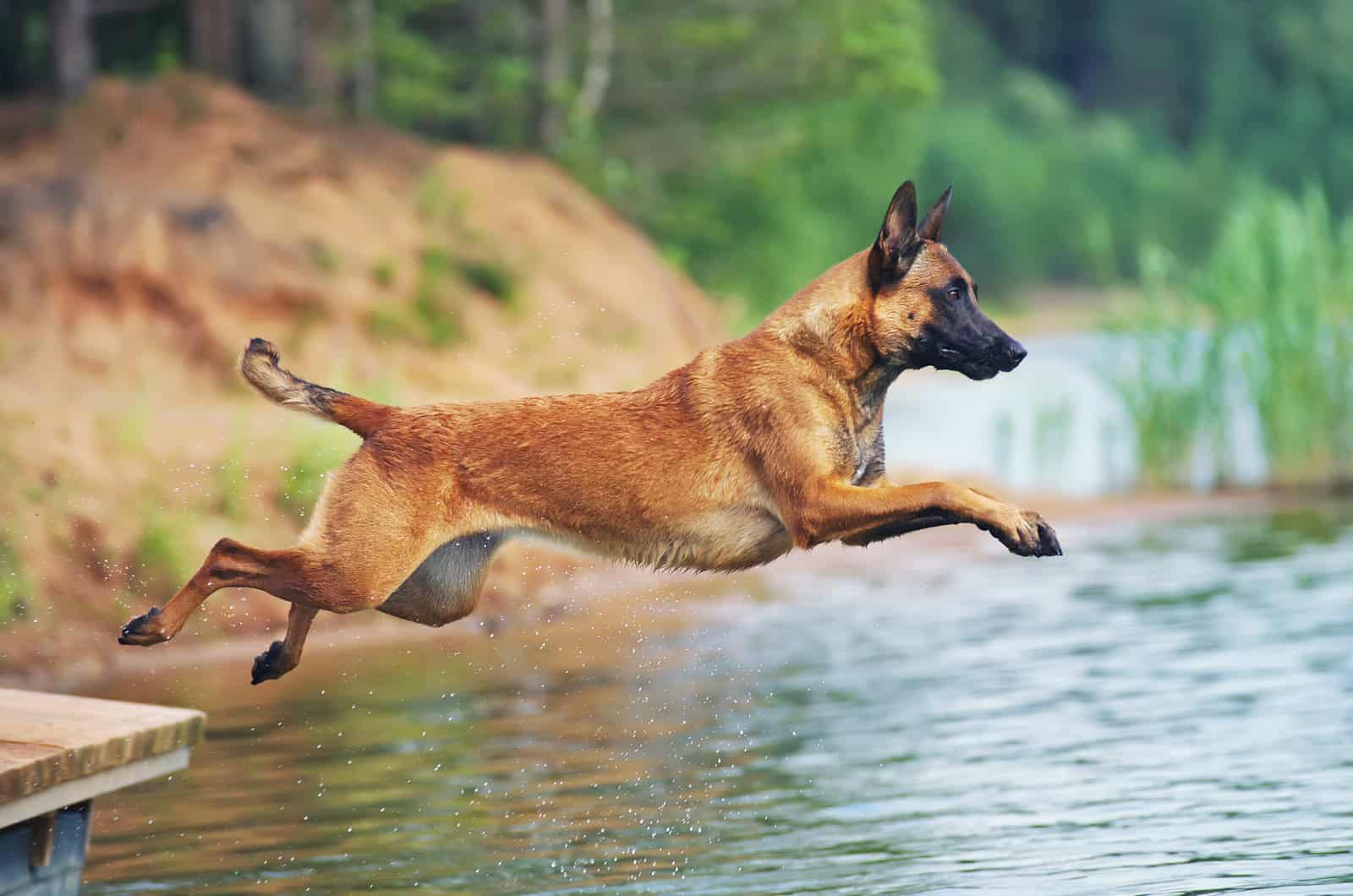
Understanding a dog’s size chart is important for many reasons. First and foremost, you need to know that your dog is of the right size as this is a great indicator of the dog’s health.
If a dog isn’t growing at the right pace, there might be something wrong with him. Whether that be a parasitic infection or a genetic defect, you need to take your pooch to the vet to eliminate all unwanted possibilities.
Similarly, if your adult dog is either gaining or losing weight, but his growth period has passed, there might be something wrong with the dog food you’re feeding him. According to the Belgian Malinois growth chart, dogs should stop gaining weight after a certain age, and any change can indicate that something isn’t right.
When it comes to full-grown Belgian Malinois, they’ll usually reach the height of 22 to 26 inches (56 to 66 cm), with a weight of 53 to 77 lbs (24 to 35 cm). Despite what many people think, they are a medium-sized breed.
Belgian Malinois are not bred for their size, but rather for their loyal temperament. As long as your pup is close to the Belgian Malinois growth chart that comes from a reputable source, such as the American Kennel Club (AKC), you shouldn’t worry about any developmental problem.
However, it’s important to note that there can be size differences in male and female dogs. This is why you should never compare your dog with just any Belgian Malinois. You need to look at dogs of not just the same age, but also the same genre.
This is what we mean:
Belgian Malinois Growth Chart
| Height in ins | Weight in lbs | |
|---|---|---|
| Adult female | 22 – 24 ins | 40 – 60 lbs |
| Adult male | 24 – 26 ins | 60 – 80 lbs |
Belgian Malinois Puppy Growth Chart
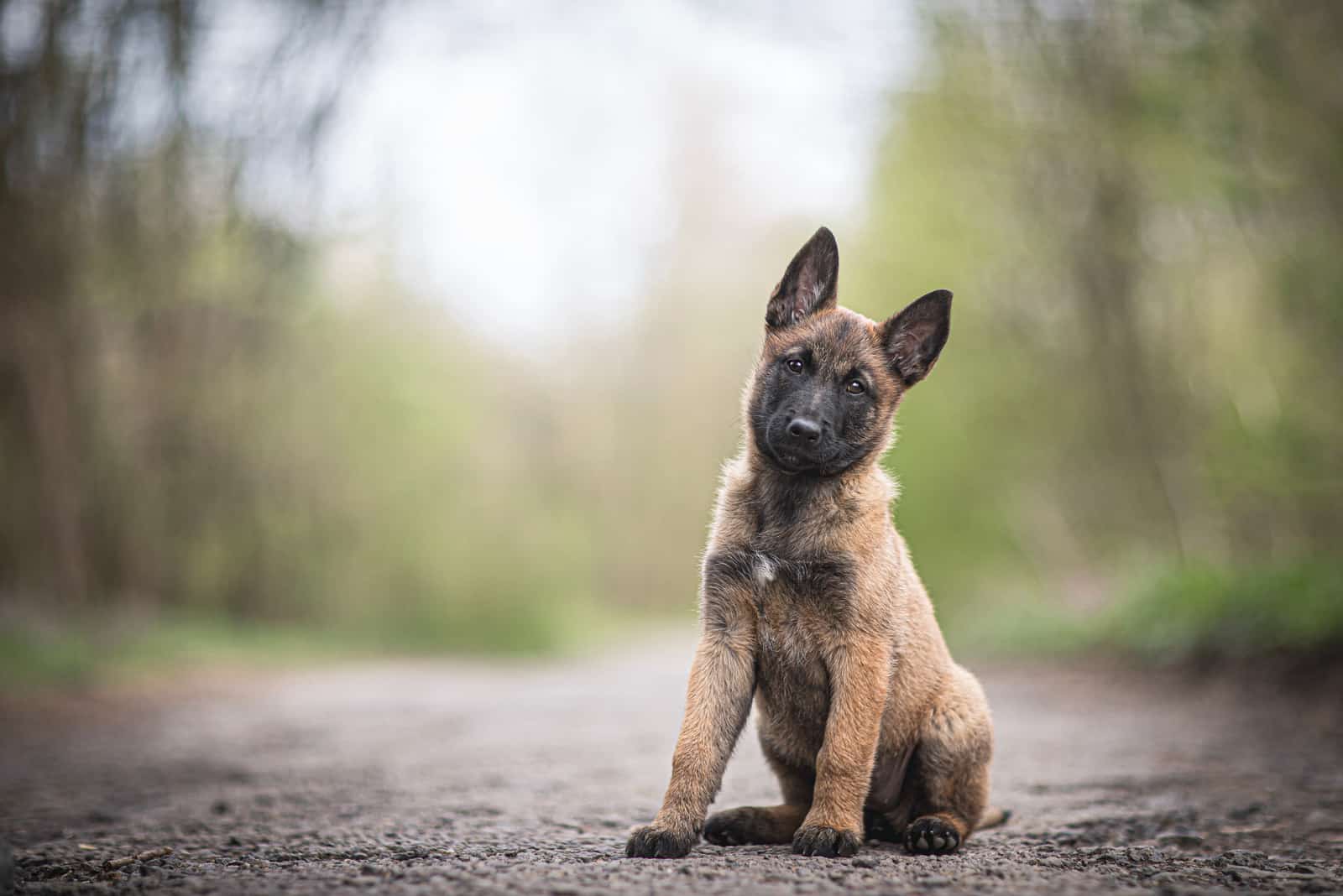
Puppies need to grow at a certain pace so they can reach their goal weight by the time they are adults. However, in order to make sure your puppy is healthy and reaches this size, it’s important to understand some special requirements of this breed.
Belgian Malinois don’t appear to be dogs that require plenty of space. However, they have lots of energy, and they’ll love to run around all day. This is why it’s important to provide them with a big back yard or to take them for several walks at the dog park each day.
Sure, Belgian Malinois can live in a smaller home. These are adaptable dogs. However, they will thrive in a large back yard where they can spend lots of time outdoors.
Not to mention that providing your Belgian Malinois puppy with as much space as possible is probably the best thing you can do for yourself and your home.
Belgian Malinois are active, intelligent dogs that have to spend most of their time busy and being entertained. If they don’t get enough physical and mental stimulation, they can become destructive, and this isn’t something that you’d want.
In fact, this is another reason why Belgian Malinois growth charts are necessary. If you don’t have an idea as to how big your new dog is going to be, you won’t be able to provide him with everything he might need.
While there are more things to consider than just size, here is a Belgian Malinois puppy growth chart for future Belgian Malinois owners:
Belgian Malinois Growth Chart
| Age | Height in cm | Height in ins |
|---|---|---|
| 3 months: | 28 – 35 cm | 11 – 13 ins |
| 6 months: | 37 – 44.5 cm | 15 – 18 ins |
| 12 months: | 50 – 55.5 cm | 20 – 22 ins |
| 16 months: | 55.8 – 66 cm | 22 – 26 ins |
Belgian Malinois Weight Chart
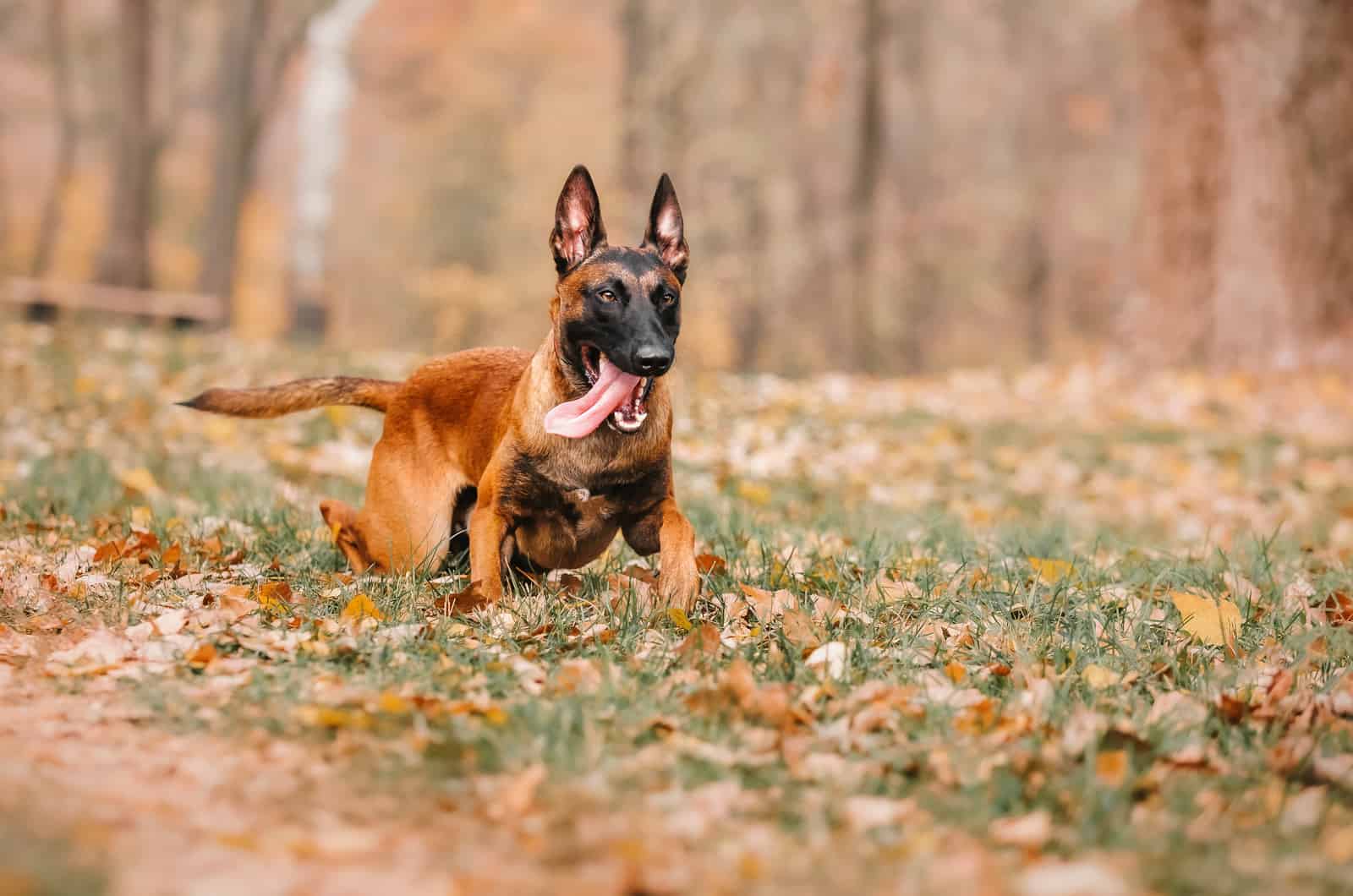
A Belgian Malinois weight chart can give you a weight estimation depending on your Mal’s age.
It’s important to note that your dog’s weight might deviate a bit from the chart as the chart can only make an estimation according to the breed average. The numbers in it aren’t set in stone, although most dogs will fall into that range.
However, if your dog’s weight deviates too much from the Belgian Malinois growth chart, you should consider getting him to the vet.
If your Belgian Malinois is way thinner than the puppy weight chart estimates him to be, chances are he has some development or health problem that has stunted his growth.
On the other hand, if his weight is much higher than it’s supposed to be, he is overweight or even obese. While this might be due to some health issue, it’s usually the result of a poor diet.
However, a few pounds outside of the normal limit is usually fine, and it doesn’t mean that there is anything wrong with your pooch.
Of course, whenever you notice that your dog doesn’t fit the Belgian Malinois weight chart, your best option is to contact the vet and ask them their opinion on the matter.
Belgian Malinois Weight Chart
| Age: | Weight in kg: | Weight in lbs: |
|---|---|---|
| 1 month | 2 – 4 kg | 4.4 – 8.8 lbs |
| 2 months | 3 – 6 kg | 6.6 – 13.2 lbs |
| 3 months | 7 – 10 kg | 15.4 – 22 lbs |
| 4 months | 9 – 12 kg | 19.8 – 26.4 lbs |
| 5 months | 11 – 16 kg | 24.2 – 35.2 lbs |
| 6 months | 12 – 17 kg | 26.4 – 37.4 lbs |
| 7 months | 15 – 20 kg | 33 – 44 lbs |
| 8 months | 16 – 22 kg | 35.2 – 48.5 lbs |
| 9 months | 17 – 23 kg | 37.4 – 50.7 lbs |
| 10 months | 18 – 25 kg | 39.6 – 55 lbs |
| 11 months | 18 – 27 kg | 39.6 – 59.5 lbs |
| 1 year | 19 – 28 kg | 41.8 – 61.7 lbs |
| 2 years | 29 – 36 kg | 63 – 80 lbs |
When Do Belgian Malinois Stop Growing?
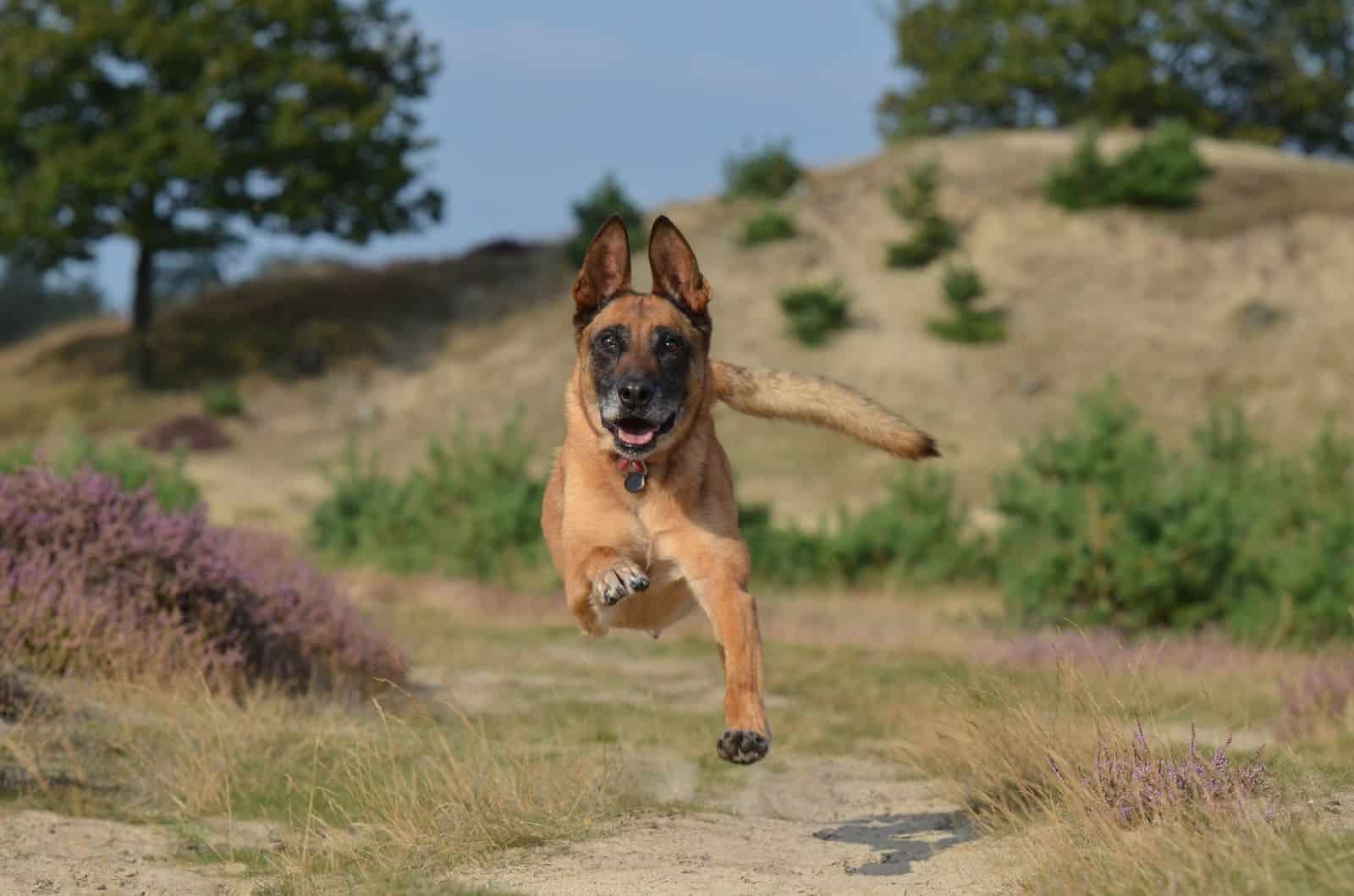
Generally, each dog always grows at its own pace, and there isn’t a strict age at which your Belgian Malinois will reach its full size. However, we can make assumptions based on the breed average.
Overall, Belgian Malinois grow to their adult height when they are a bit less than a year old – usually when they are 10 to 11 months of age.
However, they might grow a tiny bit more until they are 18 months old.
On the other hand, Belgian Malinois reach 90% of their adult weight when they are around a year old, but it takes them at least one more year until they are approximately at the weight they are going to stay at.
However, some Belgian Malinois might keep on gaining healthy weight until they are up to three years old! This entirely depends on their lifestyle and diet. Still, they usually won’t gain more than a few pounds between ages two and three.
Belgian Malinois Growth Chart – Proper Puppy Development
Belgian Malinois growth charts are there to help you understand the dog’s estimated size. However, this is of little importance if you don’t understand proper Belgian Malinois puppy development.
No matter the dog breed, all puppies go through more or less the same development, even though not all things happen at the same time. For example, small dogs grow faster than large breeds, so you can expect them to be fully grown much sooner.
A Border Collie will grow faster than a Boxer, and a Chihuahua will reach adult size faster than a Great Dane. Size is an important factor in development. As such, you can expect Belgian Malinois to grow at approximately the same pace as German Shepherd dogs.
Even some dog breeds that seemingly don’t have anything alike will grow at a fairly similar speed if their size is similar. A Bulldog will grow just as fast as a medium-sized Poodle, even though they don’t seem to have anything in common!
Now that we’ve gotten this out of the way, here is an estimated development of Belgian Malinois puppies:
Up to Two Weeks
Belgian Malinois puppies are born dependent on their mother. They are born blind, deaf, and toothless, and they won’t be able to do anything alone during this time.
Right after birth, they’ll be able to taste and touch. However, the only thing they are truly capable of doing is cuddling next to a female Belgian Malinois for milk and warmth.
Puppies will spend most of their time sleeping, and during most of their awake time, they’ll nurse. They won’t be able to walk properly as their muscles have yet to develop.
Three to 12 Weeks
At around three weeks of age, a Belgian Malinois puppy should open his eyes, and his sense of hearing should appear. His muscles will also strengthen, and he might be strong enough to stand, wag his tail, run, and bark.
As he becomes older, he’ll start to acquire teeth. He’ll start to play with his littermates, and as his eyesight develops, he’ll become more and more aware of his surroundings.
After the first few weeks, your Belgian Malinois will be ready to switch to puppy food, which is usually in the form of pate.
This is also the time when puppies, no matter if they are Belgian Malinois or any other Sheepdog, will start to attain control over their bladder. Extensive playtime will improve coordination as well.
This is the best time to start early obedience training and socialization. Your puppy will be old enough to be aware of some simple commands, although don’t expect him to listen to you. He’ll still be too young for that.
Four to Nine Months
During this time, your Belgian Malinois will start teething. This will cause him to want to chew anything in his surroundings. It’s essential that you stop him from using his teeth now as the later you do this, the lower the chances of success.
Also, this is the moment to strengthen the bond between you and your puppy. As your Belgian Mal will have received all his vaccines by this moment, you will be able to start socializing your pooch.
The earlier you start with dog training and socialization, the higher the chances of success are. Remember, you are the dog’s pack leader. The two of you need to have that special bond, and the only option to create it is to spend some quality time with your doggie.
Remember to keep up with dog training. Also, spend a lot of time on exercise and playtime. This is great not just for socialization, but also for improving muscle and bone health.
10 to 18 Months
This is the time when your Belgian Malinois will reach his sexual maturity. At this age, you can expect some drastic changes (mostly hormonal) in your dog. Once again, this isn’t something that all dogs go through at the same time. Some dog breeds might take longer to become mature.
Female Belgian Malinois will go into heat twice a year. This means that if you don’t spay them, they’ll be able to have at least two litters each year.
Males usually take more time until they are sexually mature. They’ll be sexually active throughout the year, but they’ll be the most fertile when they are anywhere between 12 and 18 months old.
Older than 18 Months
Belgian Malinois are full-grown once they are between a year and two years of age. This is the moment when they start behaving as regular Belgian Malinois do, but they’ll still enjoy spending time with their owners.
There aren’t many changes to be expected in the adult stage. Once your pooch grows old enough, things are likely to stay the same way.
If you notice any sudden weight gain or weight loss, contact your local vet immediately. Your dog might be dealing with some health issue that needs to be checked.
Why Is My Belgian Malinois So Small? Possible Reasons
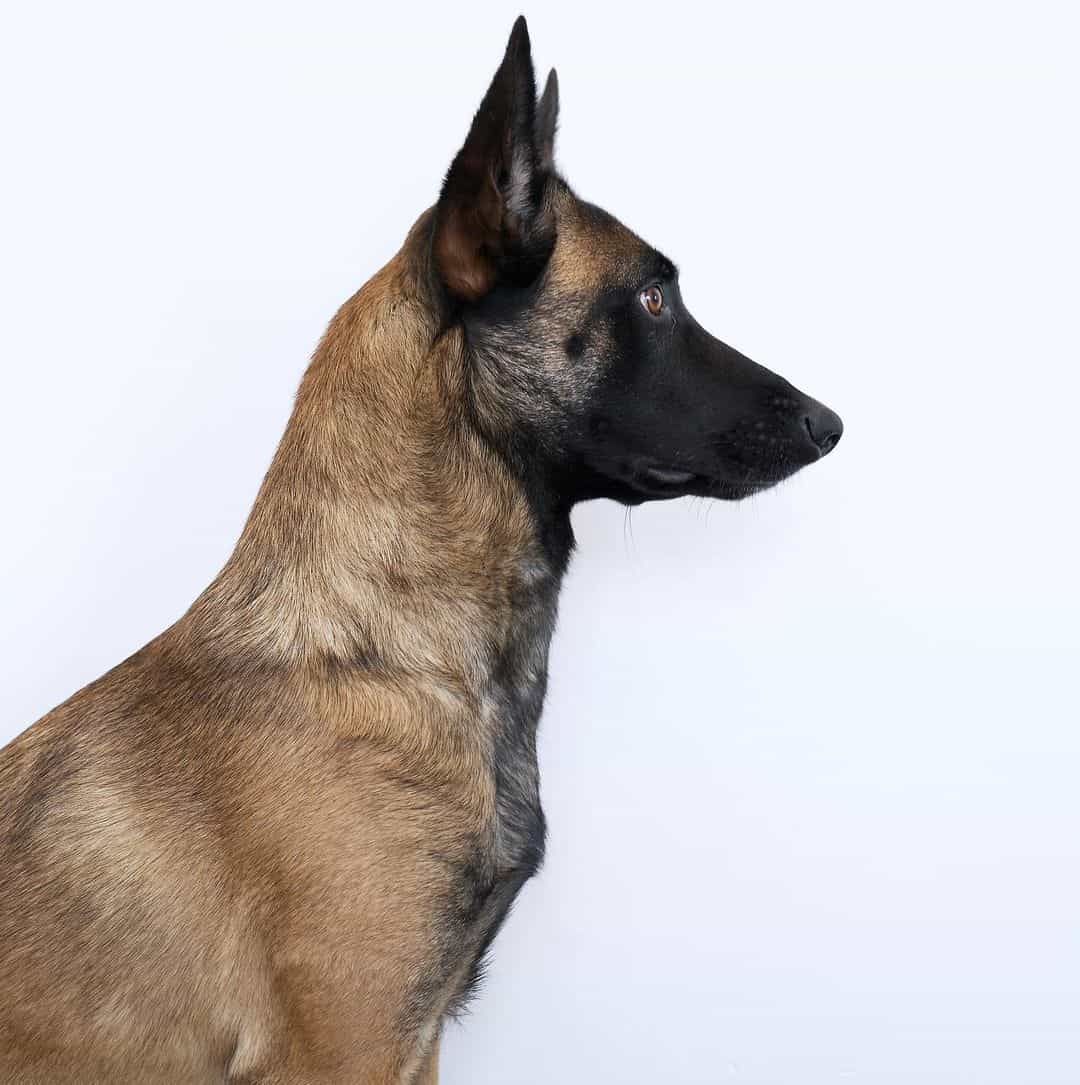
Photo from: @tactical_k9_family
There are several factors that might affect a Belgian Malinois puppy’s growth.
If you notice that your puppy is overweight, you’ll probably think that he has eaten too much food and is struggling with obesity. Opposite of that, if you notice that your Belgian Malinois is underweight, you’ll likely think that this is because of stress. But, are these scenarios possible?
Here are some factors that might affect puppy growth and cause dogs and their owners to fall out of the American Kennel Club (AKC) breed standard and Belgian Malinois growth chart:
Genetics
This one is rather obvious. The main reason behind any change in a Belgian Malinois’, a Labrador Retriever’s, or a Belgian Shepherd’s size lies in the dog’s genetics and inherited concerns.
Many diseases that will make a Belgian Malinois appear overweight or appear underweight are, in fact, hereditary. The same goes for genes that determine the dog’s size. This means that there are high chances that the puppy will grow up to be as large as his parents.
This is why it’s important to always buy from reputable breeders who will allow you to see the dog’s parents. The best way to see how big your dog is likely going to be is to look at his parents.
Gender
Most dog breeds possess a certain amount of sexual dimorphism. This means that there are some differences between the genders, and two of them are height and weight.
In canines, males are usually taller than females. This size difference can sometimes be almost unnoticeable, while on other occasions, it could be visible even to someone who isn’t familiar with the breed in question.
This is why most Belgian Malinois growth charts have separate charts for males and females.
Diet
Proper nutrition in puppyhood might be the key to a puppy’s size. A dog’s ability to grow to its full size is very much impacted by the food you give it. This is why it’s essential that you feed your puppy the best dog food for Belgian Malinois you can get.
If a puppy doesn’t eat good food that has all the nutrients he needs, his growth and development might be impacted. Dogs of all breeds: Beagles, Australian Shepherds, and Corgis alike, all require proper nutrition. If they don’t get it, they won’t grow.
Low-quality, cheap food usually doesn’t have all the minerals and vitamins your beloved pet might need. In fact, chances are they even have harmful ingredients.
If you want your Belgian Malinois to reach his full size, you need to feed him properly.
Fortunately, most brands have their ingredient lists publicly displayed, whether that is on the manufacturer’s page, or on the Amazon site.
Make sure to inspect everything you’re feeding your dog in order to avoid any complication.
Read Next: Belgian Malinois Feeding Chart
Health And Physical Activity
Belgian Malinois are alert, active dogs. For them to match the numbers on the Belgian Malinois growth chart, you need to make sure they get enough exercise.
Belgian Malinois will require more exercise and training than most other dog breeds. For example, Cocker Spaniels and Yorkshire Terriers don’t require that much playtime, but Anatolian Shepherds, Rottweilers, and many other larger dogs do.
If you don’t allow active dogs to run around as much as they need, you’ll halt the development of their joints and bones.
Also, there are some health conditions that might halt the dog’s growth rate. Ringworms, for example, can make dogs grow much slower as they’ll absorb most of the nutrients your dog intakes.
This is why it’s important to take your pooch to the vet if you notice he isn’t growing as much as he is supposed to, or if you notice any sudden weight gain.
Fortunately, Belgian Malinois aren’t prone to many health problems, which is why they have a fairly decent lifespan of 10 to 12 years.
However, all dog breeds can acquire some health issues that will affect their growth.
Are Belgian Malinois a Large Breed?

Photo from: @_shelbywise
Despite being labeled dangerous canines by many, Belgian Malinois are usually not large dogs. They are considered medium-sized, although some might grow to be quite large.
For example, they are similar in size to Bullmastiffs, although they weigh less due to their different body structure and muscle mass.
However, they are nowhere near as large as Bernese Mountain Dogs, which are true gentle giants!
In the end, the main reason why you’d want your dog to match the Belgian Malinois growth chart is that the dog’s size is a great indicator of whether your dog is healthy or not.
If your Belgian Malinois is overweight or underweight, or if he’s growing at a slow rate, chances are there are some underlying health conditions that are causing this.
This is why it’s important to always have a responsible vet you can trust who will be able to use a weight calculator and other methods to let you know whether your dog is of a healthy weight, and whether they suspect there is some health issue that needs to be dealt with.
No matter the size, Belgian Malinois make great guard dogs, and with some proper training, they can be great family companions.
However, these dogs are not for everyone, so make sure you’ve got what it takes before you become a Belgian Malinois owner.
Read Next:
• Dogue De Bordeaux Growth Chart: How Big Are French Mastiffs?
• Kangal Growth Chart: How Big Do These Tough Pups Get?













